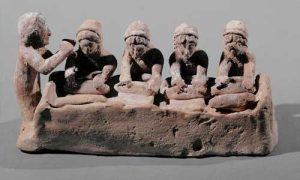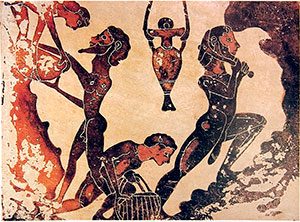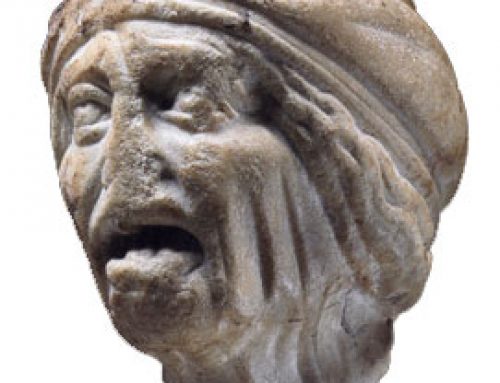
Greek slaves: An enslaved woman playing a kithara. You can tell she is a slave because she has short hair.
What did Greek slaves work at?
In ancient Greece, most people who worked at jobs were slaves instead of free people.
That was true for teachers, doctors, and nurses. Construction workers, policemen, hair-dressers, and mail carriers were also slaves.
So were cooks, nannies, and bakers. In ancient Greece, miners, farmhands, dancers, musicians, craftspeople, and accountants were all mostly slaves.
(More about musicians in ancient Greece)
Why did ancient Greece have so many enslaved people?
No money or clocks

Women kneading bread while a flute player keeps the production speed up.
There were a lot of enslaved people partly because free Greek people had no money to pay workers with (until the Archaic period). Nobody had invented money yet. Also, they had no clocks to measure how long somebody had worked. Nobody had invented clocks yet.
Cheaper than paying workers
But it was also because it is cheaper to force people to work for you than it is to pay them.
Slaves can’t vote
And, if people are slaves, they do not vote in your democracy – only free men could vote. So rich people didn’t have to worry about what working people thought about their government.

An enslaved man cooking (Athens, 400s BC)
How did people get enslaved?
Most people who were slaves in Greece had been born free. Their parents sold them into slavery when they were children. They didn’t because their parents were too poor to take care of them.
Or they were captured by kidnappers or as prisoners of war and sold as slaves.
A few slaves were the children of other slaves. Most slaves were Greek people from

A wool workshop in Archaic Greece: women making woolen cloth to sell.
other cities, and some were Persians or Egyptians or Scythians.
What was it like to be enslaved?
There were a lot of jobs, and so about a third of the people living in ancient Greece were slaves. Slaves were owned by other people, and had to work for their owners. They could not decide to go work for somebody else.
If they refused to work, their owner hit them or starved them. People who were slaves could not marry or raise children without their owner’s permission. And their owner could sell them or their children at any time.

A free man beating an enslaved man.
Slave farming in Greece
Most people in ancient Greece who were enslaved worked in the fields, plowing and planting seeds and harvesting wheat and barley and olives.
Some enslaved people worked for small farms, maybe just one or two slaves working alongside their boss.
Others worked on huge farms with hundreds of other slaves, and never saw their owner. These people who worked in the fields as slaves were almost all men.

Greek man vomiting after drinking too much wine: a slave holds his head.
Greek slaves fishing and pearl-diving
Many other enslaved people – also mostly men – worked on fishing boats, or were pearl-divers – a dangerous and difficult job.
Greek slaves in manufacturing
Both men and women worked as slaves in factories or small shops, making shoes or shields or pottery or leather.
As in other countries, a lot of enslaved women worked in huge spinning and weaving workshops. These women made high quality linen and wool cloth for their owners to sell.
Slaves as servants or entertainers
Some people cut hair in barbershops, and others worked in the public baths. Both boys and girls were forced to work as prostitutes. People who could read and write were often teachers or accountants. Or people who had skills might be musicians or dancers. People often freed skilled slaves when they got too old to work. We’re not sure whether this was good or bad for them.

A slave nanny taking the baby (see the loom behind her?) Greek red-figure vase from Athens, about 450 BC
A smaller number of Greek slaves worked as servants in the houses of their owners. Women worked as wet-nurses, or as nannies, or as cleaning women or cooks. They emptied chamber pots and went to get water from the public fountains.
Slave rowers on ships
Men worked taking care of the horses, or walking free boys to school, or as handymen or gardeners. Enslaved men went to the market to do the shopping every day. These people, too, were often freed when they got old and couldn’t work anymore.

Sailors rowing trading ships (Athens ca. 550 BC)
Some unlucky men worked as slaves rowing trading ships. Ship captains kept them down in the bottom of the ship so they never saw the sun. The captains gave them only bread and water to eat. The ship’s crew beat the rowers with sticks to make them pull the oars harder. Most men who worked as rowers didn’t live very long.
Slaves in the silver mines

Silver mining slaves at Laurion, near Athens
But the men that were the worst off were the men who worked as slaves in the silver mines. The silver in the mines was mixed with lead. So the men who worked in these mines gradually died of lead poisoning. Nobody lived more than two or three years. Their owners knew that the slaves were being poisoned, but they didn’t care.
Some of these slaves were criminals, murderers or thieves who were being punished by working as slaves. Others were slaves who had tried to run away from other jobs, or had refused to work. But many slaves went to the mines for no reason at all, just because people were needed to work in the mines, and free people didn’t want that kind of work.
Looking for more sources? Check out ancient writing about slavery in the Internet History Sourcebook.
Did you find out what you wanted to know about Greek slaves? Let us know in the comments!
Learn by doing: spend a morning u-picking strawberries or tomatoes
More about slavery
Bibliography and further reading about Greek slavery:
Eyewitness: Ancient Greece , by Anne Pearson. Easy reading.
You Wouldn’t Want to Be a Slave in Ancient Greece!, by Fiona Macdonald and others (2000). – funny illustrations, but real facts.
Slavery in Ancient Greece, by Yvon Garlan (revised 1988). A standard account, meant for adults but not too hard going.
Greek and Roman Slavery, by Thomas Wiedemann (1989). A collection of more than 200 things ancient writers had to say about slaves and slavery. Draw your own conclusions.








who published this?
The publisher is Quatr.us Study Guides
wheres all the info i came here for?
What were you looking for? Maybe I can help.
this did not give me any informtaion
I’m sorry to hear that, Gia! Ask your questions here and I’ll try to answer them.